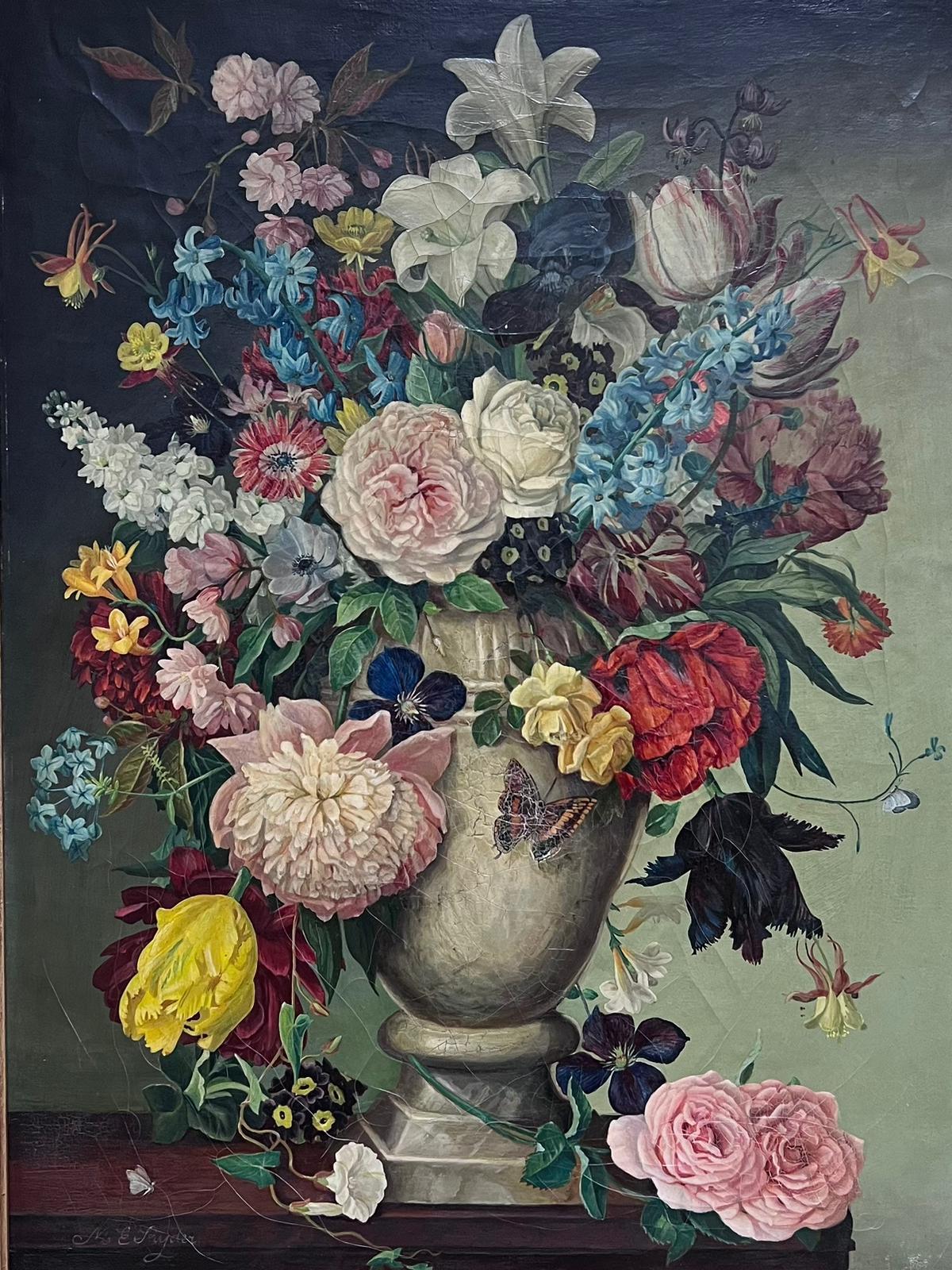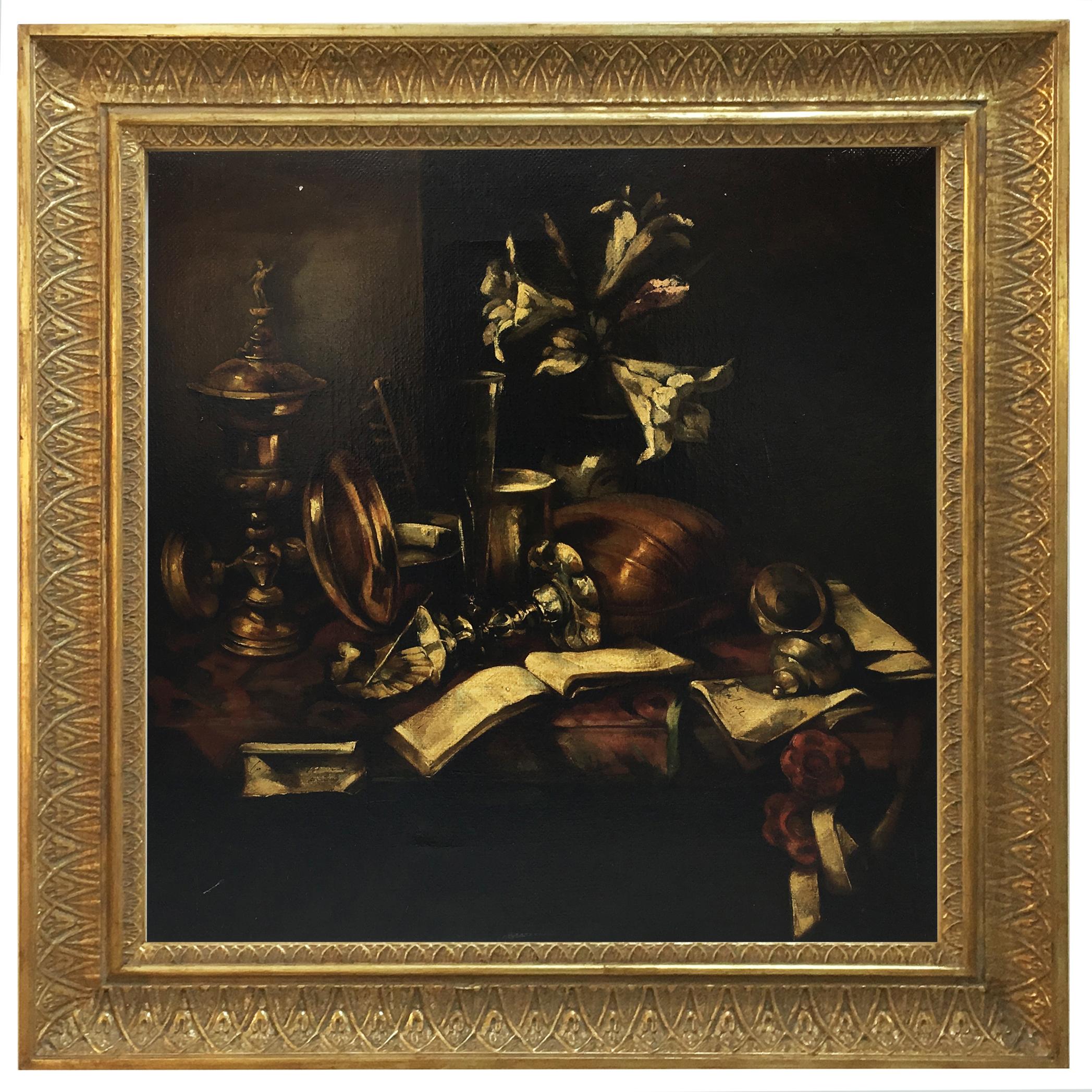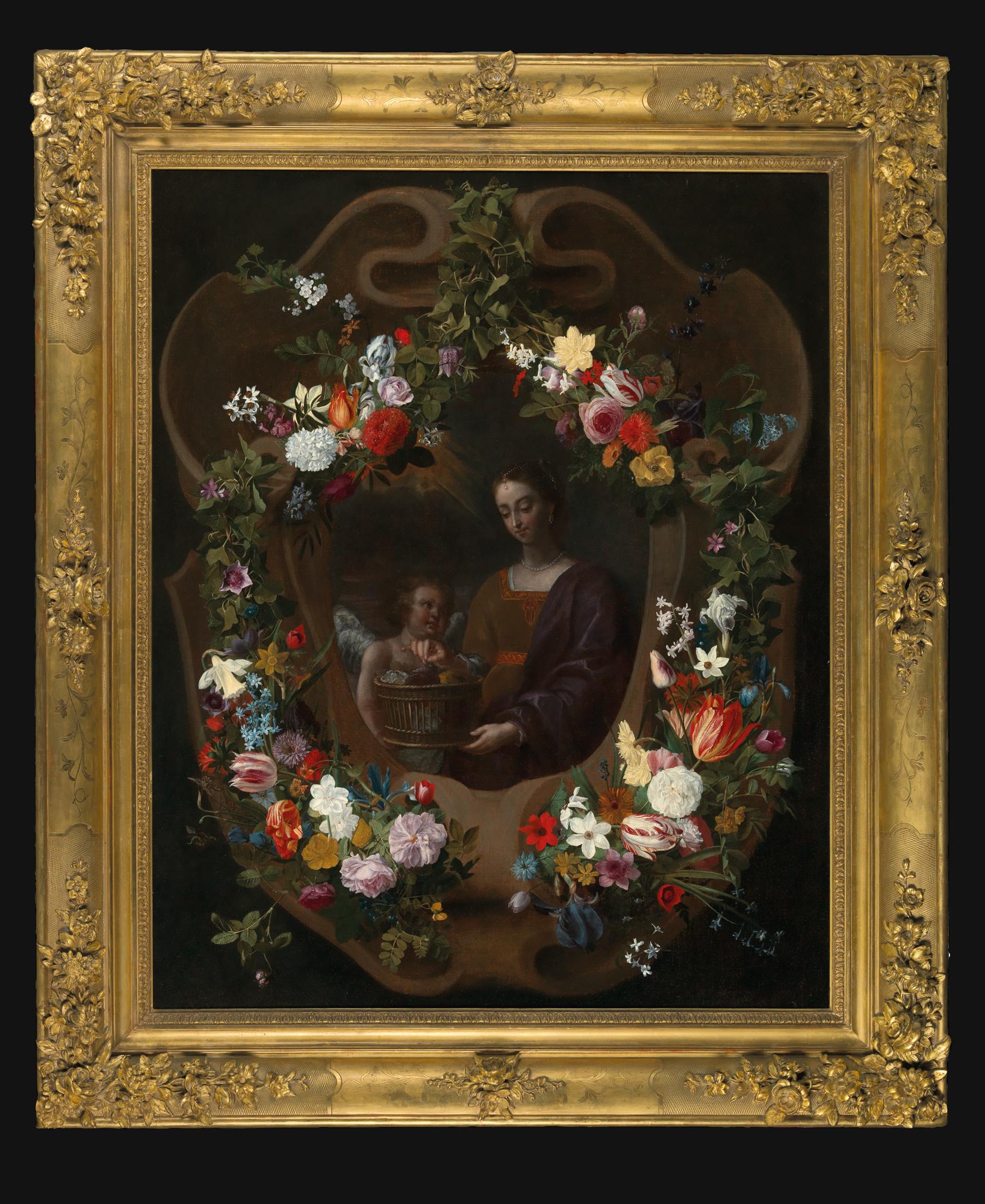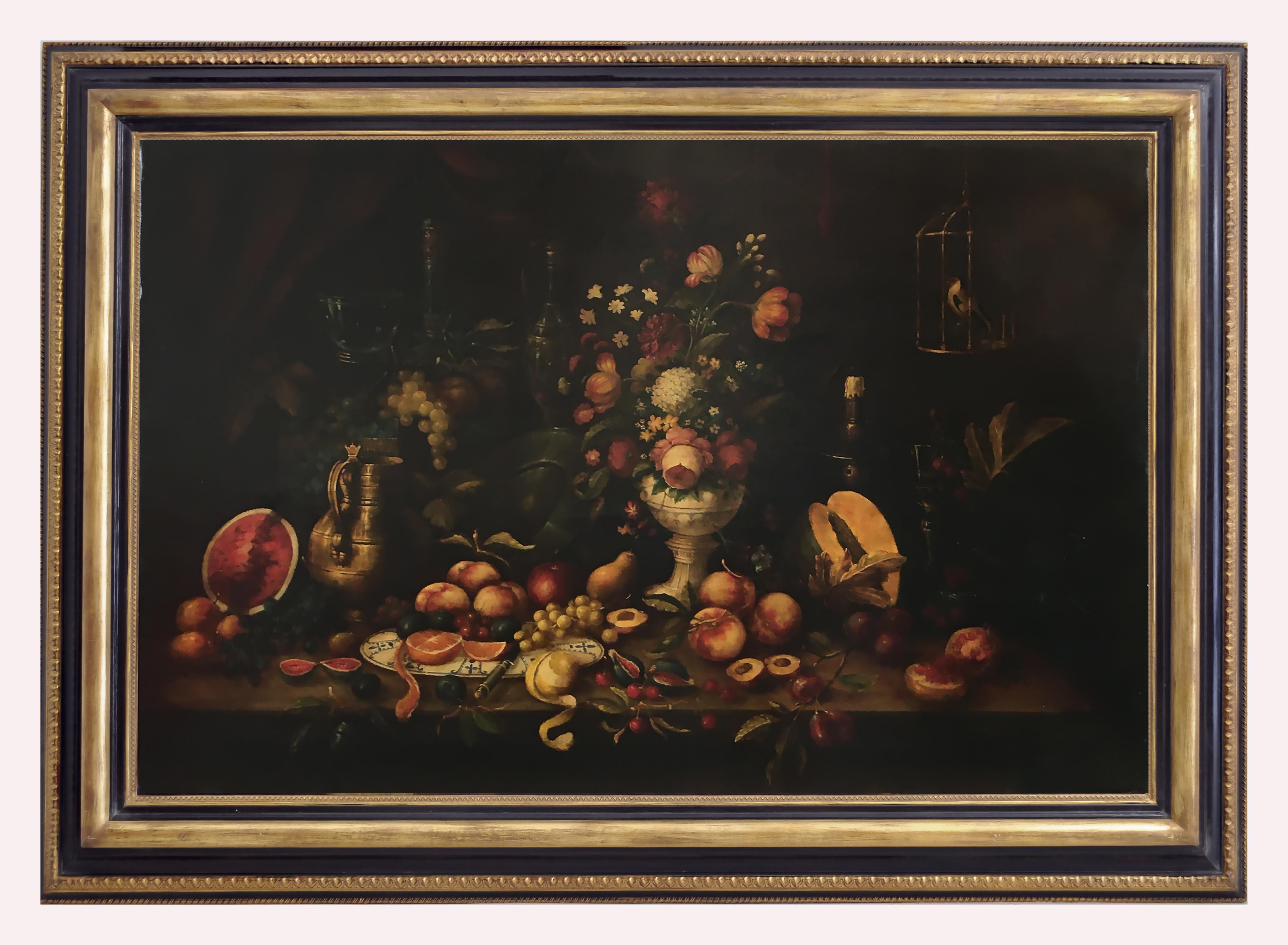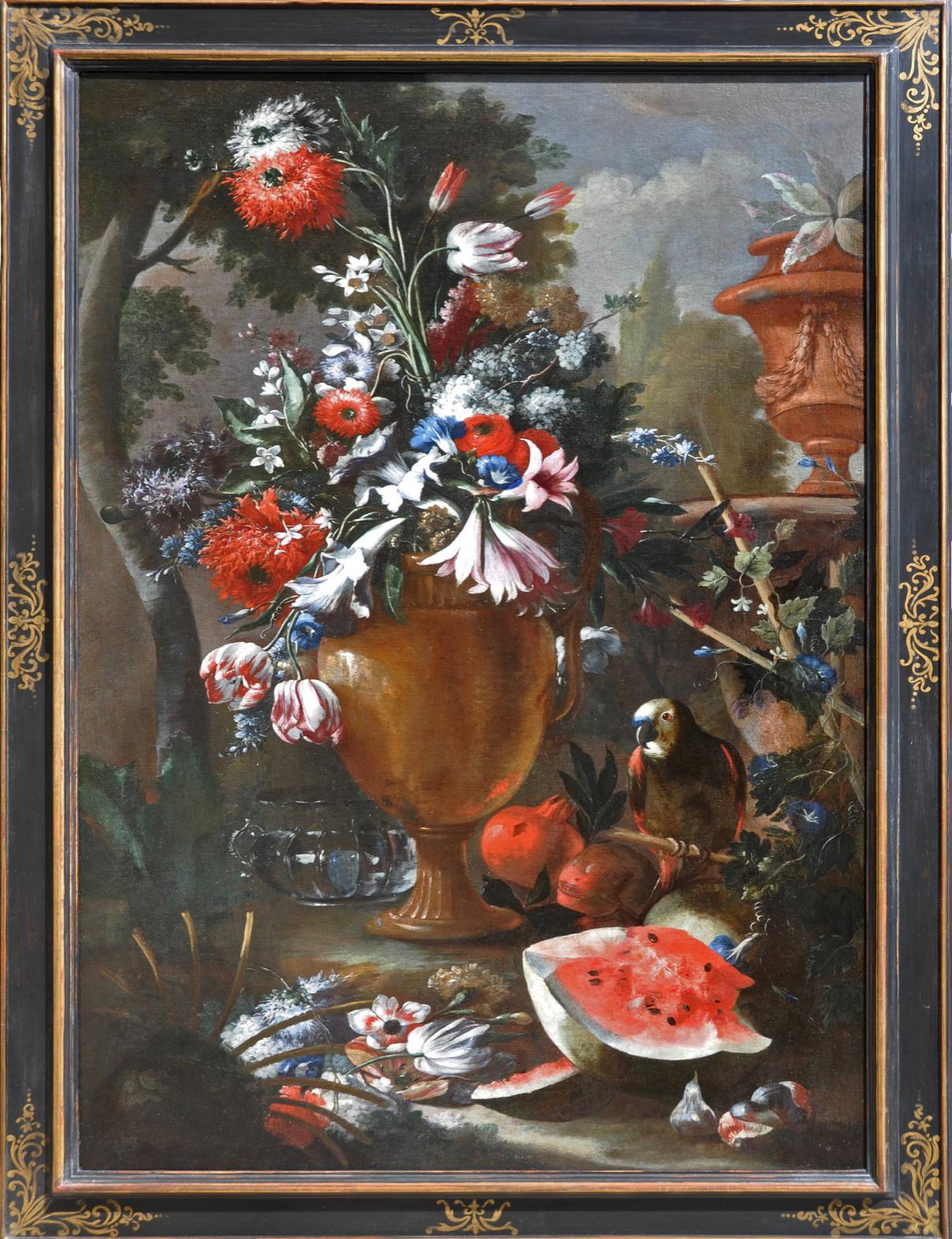Items Similar to 19thC French Classical Still Life Flowers & Ornamental Fruit, Ideal Interiors
Want more images or videos?
Request additional images or videos from the seller
1 of 9
French School19thC French Classical Still Life Flowers & Ornamental Fruit, Ideal Interiors
About the Item
Artist/ School: French School, 19th century
Title: Classical Still Life with ornamental flowers and fruit.
Medium: oil painting on canvas,framed
Size:
framed: 17 x 20 inches
canvas: 14.5 x 17.5 inches
Provenance: private collection, France
Condition: The painting is in overall very good and sound condition, minor surface scuffs and scratching.
- Creator:French School
- Dimensions:Height: 17 in (43.18 cm)Width: 20 in (50.8 cm)Depth: 1 in (2.54 cm)
- Medium:
- Movement & Style:
- Period:
- Condition:
- Gallery Location:Cirencester, GB
- Reference Number:1stDibs: LU509310540422

About the Seller
5.0
Platinum Seller
These expertly vetted sellers are 1stDibs' most experienced sellers and are rated highest by our customers.
Established in 1989
1stDibs seller since 2016
3,578 sales on 1stDibs
Typical response time: 2 hours
- ShippingRetrieving quote...Ships From: Cirencester, United Kingdom
- Return PolicyA return for this item may be initiated within 3 days of delivery.
More From This SellerView All
- Fine Classical Still Life Summer Flowers, British Oil Painting Exhibition labelLocated in Cirencester, Gloucestershire'Summer Flowers' by Margaret Ryder (British b. 1908) signed oil on canvas, framed frame: 33 x 26 inches canvas: 27 x 20 inches provenance: private collection, UK Exhibited at the Roy...Category
Mid-20th Century Old Masters Still-life Paintings
MaterialsOil
- Very Large Classical Oil Still Life Study Of Fruit and FlowersBy Emilio GrecoLocated in Cirencester, GloucestershireManner of Emilio Greco, 20th Century oil on board, framed framed: 24 x 29 inches board: 16 x 20 inches provenance: private collection, England The painting is in very good and presen...Category
20th Century Old Masters Still-life Paintings
MaterialsOil
- Fine Classical Still Life Oil Painting Ornate Flowers in Vase Gilt Framed OilLocated in Cirencester, GloucestershireClassical Still Life of Flowers French School, early 20th century oil on board, framed framed: 12 x 8.5 inches board: 11 x 8.5 inches provenance: private collection, France condition...Category
Early 20th Century Old Masters Still-life Paintings
MaterialsOil
- Fine 18th Century Old Master Oil Painting Dead Game in LandscapeLocated in Cirencester, GloucestershireStill Life with Dead Birds 18th Century Italian School oil painting on canvas, framed framed: 17 x 21 inches canvas: 14 x 18 inches provenance: private collec...Category
18th Century Old Masters Animal Paintings
MaterialsOil
- Fine Spanish Old Master style Oil Painting in Ornate Frame Flowers Ornate VaseLocated in Cirencester, GloucestershireStudio of Miguel Canals, Spanish 1925-1995 Still life painting with flowers in a vase oil on canvas, unframed canvas: 23 x 18 inches provenance: private ...Category
20th Century Old Masters Still-life Paintings
MaterialsCanvas, Oil
- Large Spanish Old Master style Oil Painting Ornate Flowers in VaseLocated in Cirencester, GloucestershireStudio of Miguel Canals, Spanish 1925-1995 Still life painting with flowers in a vase oil painting on canvas, framed oil on canvas, unframed canvas: 23 x...Category
20th Century Old Masters Still-life Paintings
MaterialsOil, Canvas
You May Also Like
- Still Life - Francesca Strino Italian oil on canvas paintingBy Francesca StrinoLocated in Napoli, ITStill life - Francesca Strino Italia 2005 - Oil on canvas cm.60x60 Francesca Strino, a Neapolitan painter, realises this still life with great pictorial realism. The painter has her ...Category
Early 2000s Old Masters Still-life Paintings
MaterialsOil, Canvas
- Grand-Scale Old Master Garland Portrait, 17th Century, Signed & Dated, Rare workLocated in London, GBIndistinctly signed and dated In the first quarter of the 17th century a new form of flower painting was developed in Flemish painting, which, recreated by a large group of artists and workshops, would achieve considerable success throughout the century in much of Europe: the garland of flowers surrounding a central figure. Brueghel de Velurs was the initiator of this type of composition, however, it was his pupil, Daniel Seghers, who was the dominant figure in this specialised production and the creator of a prototype that would serve as a model for the numerous artists who followed in his wake. It seems undeniable that the artist of the present painting had seen the Garlands of Flowers Surrounding a Medallion Depicting the Triumph of Love by Daniel Seghers and Domenico Zampieri (now in the Musée du Louvre in Paris). In our painting, the present floral wreath encircles a carved cartouche within which sits Saint Dorothy of Caesarea and the attribute which often accompanies her in art, a basket of roses. The extremely delicate flowers have been rendered in meticulous detail, so that every species can be identified from exotic tulips to roses, irises and forget-me-nots; this obvious attention to naturalism is inherited from the Flemish manner. Each flower is so precise and refined that they are an individual study in their own right. The still-lifes are from the hand of Jan Anton van den Baren, with the central figures by another accomplished hand. Van den Baren’s arrangement of flowers would have delighted connoisseurs in both Flanders and in Vienna, where the impossibility of their all blooming at the same time of year would have been understood as a further statement of the wonder and beauty of the divine. Van den Baren worked first in Brussels, where he collaborated with Erasmus Quellinus II for the figures in his works, before moving with Archduke Leopold Wilhelm, his patron, to Vienna in 1656, where he instead worked with fellow Flemish émigré painter Nikolaus van Hoy. The iconography relates to an eighth century legend where she was presented a basket of roses by a child. In addition to the brilliance of his handling of still-lifes Van den Baren played an important art historical role as Director of Archduke Leopold Wilhelm’s Picture Gallery in Vienna, then one of the greatest collections in the world and the core of what was to become the present collection of the Kunsthistorisches Museum, Vienna. Van der Baren compiled an inventory of the collection in 1659, and his predecessor as Director of the Archduke’s Picture Gallery (when it was still housed in Flanders), David Teniers, depicted van der Baren (third from right) in his celebrated Archduke Leopold Willem in his gallery at Brussels, conserved at the Kunsthistorisches Museum. It is a shining example of the Flemish Baroque and is a very rare object indeed, considering there are only 14 paintings accepted as authentic works by this artist. We are grateful to Fred Meijer for confirming the attribution to Johannes Antonius van der Baren. A feature of this painting is its outstanding carved and gilded frame with a plethora of flowers and foliage. Titan Fine ArtCategory
17th Century Old Masters Portrait Paintings
MaterialsCanvas, Oil
- Still Life - Italian Oil On Canvas Painting by Antonio JannoneBy ANTONIO JANNONELocated in Napoli, ITStill life - Oil on canvas cm.100x150, Antonio Jannone, Italy, 2003. Frame available on request.Category
Early 2000s Old Masters Still-life Paintings
MaterialsCanvas, Oil
- A still life of flowers in an urn with a parrot, melon, pomegranates and figs...By Aniello Ascione (Naples, news from 1680 to 1708)Located in Stoke, HampshireAniello Ascione (Naples, fl. 1680-1708) A still life of flowers in an urn with a parrot, melon, pomegranates and figs at its base, a view to an ornamental garden beyond Oil on canvas 59 3/4 x 39 3/4 in Provenance The Alexander Family Collection, Milford House, Co. Carlow, Ireland The latter half of the 17th century and earlier 18th century marked the golden age of Neapolitan still-life painting and Aniello Ascione was one of its most highly regarded exponents. His sumptuous paintings, brimming with fecund produce of the Mediterranean and painted in rich colours, were eagerly sought after by those who wished to decorate their palaces in that city. Naples in the seventeenth century had established a significant reputation and artistic tradition of producing flamboyant and technically excellent still-lifes which had largely been initiated by Caravaggio who, having stated that it required as much effort to paint a good flower piece as a figure subject, helped to revolutionise and eventually abolish the closed attitude to genres of painting. Caravaggio maintained that art was the mirror of nature and his superb Basket of Fruit, now in the Ambrosiana in Milan and painted in 1597, marked the birth of European still-life painting. Throughout the 17th century, Neapolitan still-life painting was founded on the principles demonstrated by Caravaggio and these artists seem to have been the only ones to correctly understand and utilise his ideas. These paintings were noted for their vibrant portrayals of flowers, often in great abundance, fruit and birds done in an elegant and decorative manner. Luca Forte (c.1615- c.1670) was one of the first Neapolitan artists to adopt the Caravaggesque naturalism in this genre of painting and with exceptional creativity sweeping through the city in the 1630s, he was soon followed by Paolo Porpora and Guiseppe and Giovanni Battista Recco and the Ruoppolo family. When Abraham Brueghel arrived in Naples in about 1670, his influence accelerated the transition of the portrayal of still-life to a more baroque style often epitomised by a mass of flowers, cascading over classical objects like water. This more baroque style was taken up by a new generation of painters and one of the first and most prominent of these was Andrea Belvedere (1652-c.1732). He taught Nicola Casissa and other artists working in a similar vein included Gasparo Lopez (called Gasparo di Fiori) d. circa 1732, Paolo Porpora (1617-1663) and Nicola Malinconico (1663-1721). The aforementioned Ruoppolo family were also eminent and Giovan Battista Ruoppolo (1619-1693) instructed the young Aniello Ascione. His pupil became one of the most celebrated representatives of Neapolitan Baroque which combined the traditional naturalism favoured by the city with the new 18th century decorative style. This style proved highly popular with the more secular Neapolitan middle classes as well as the aristocracy and royalty to furnish their grand homes. They loved the harmonious colouring and composition suffused with exuberance Ascione became the most prominent still-life painter in Naples at the transition from the seventeenth and eighteenth centuries. His paintings, which are often of a significant size, utilise intense decorative colours with an abundance of flowers and piles of fruit such as pomegranates, grapes, peaches, pears, melons and plums. Sometimes these spill down stone steps or are draped or stacked with flowers among classical statuary and there is often a view to a landscape or ornamental garden beyond to give the composition depth. Accompanying the fruit and flowers, Ascione occasionally added parrots, dogs or rabbits and he often signed with a monogram comprised of interlocking As although there are some works signed in entirety. His smaller pieces tended to be more intimate in construction with one looking at just different fruits with some of its foliage so that the different hues and skin textures could interact and to some extent, these reflect the legacy of Abraham Brueghel. One very rare piece, now in the Castellino collection in Naples, is a kitchen interior with a skinned lamb which owes its influence to Guiseppe Recco. There is a fine set of the Four Seasons, which also incorporates putti into the compositions and which are believed to have been contributed by Nicola Vaccaro (1659-1720) the son of Andrea Vaccaro...Category
17th Century Old Masters Still-life Paintings
MaterialsOil
- Baroque silver Vase with Flowers with a Fruit Tray and a Clock by A. ZuccatiLocated in PARIS, FRThis unpublished composition is a recent addition to Adeodato Zuccati’s catalog. The study of this painting by Gianluca Bocchi, an Italian art historian specializing in Italian still lives, is available upon request. This composition is typical of the productions of Adeodato Zuccati, an Emilian painter...Category
Late 17th Century Old Masters Still-life Paintings
MaterialsCanvas, Oil
- Ten dog studies and a study of a stole, a panel attributed to Jan WeenixBy Jan WeenixLocated in PARIS, FRThis painting is typical of the art of Jan Weenix, one of the best still life and hunting painters of the Dutch Golden Age. In a cleverly disordered manner, he depicts ten studies of dogs (mainly spaniels and greyhounds) and the sumptuous study of a stole. These studies were probably intended to be used as a source of inspiration and adapted in the painter's compositions, as we will see in a close examination of some of his paintings. 1. Jan Weenix, a prolific still life painter Jan Weenix was born into a family of artists: his father Jan Baptist Weenix (1621 - 1659) was also a landscape and still life painter and his mother Josyntgen d'Hondecoeter was the daughter of the animal painter Gillis d'Hondecoeter (1575 - 1638). His father trained him together with his cousin Melchior d'Hondecoeter (1636 - 1695). In 1664 Jan Weenix became a member of the St. Luke's Guild in Utrecht, to which he belonged until 1668. In 1679 he married Pieternella Backer with whom he had 13 children. His compositions, often related to hunting (still lifes, portraits of hunters) were very successful, ensuring him a certain financial ease. Jan Weenix also painted large-scale decorations: while staying in Düsseldorf with the Prince-Elector of the Palatinate between 1702 and 1712, he executed twelve gigantic compositions combining landscapes, hunting scenes and still life for the Bensberg hunting lodge. 2. Description of the artwork The painting displays a great apparent disorder that hides a rigorous organisation in four quarters. It presents ten studies of hunting dogs and one study of a stole. The studies of the stole and of two of the dogs (the greyhound in the lower right and the spaniel in the upper right quarter) are quite elaborate, whereas those of the other dogs are sketchier. As an example, the dog in the upper right corner is only partially painted. The dogs' coats, of different colours - brown, sandy, grey or black - stand out against the warm brown background and are illuminated by the shine of their white hair. This white colour, probably executed with ceruse white, illuminates the study of a stole which stands out in the lower left-hand corner while the red colour of its lining warms up the composition. The purpose of this stole is enigmatic: we think it is probably a neckband, but it could also be the back of the turban of an oriental character. To the right of this stole is the outline of a long animal leg, perhaps a horse leg. Similar studies are rare in the work of Jan Weenix, but the Rijksmuseum recently acquired the study of a seated monkey. This study, executed in the same brown chromatic range, is much more accomplished. It has been reused with minimal change in many compositions. It is likely that Jan Weenix had less frequently a monkey at his disposal, and that he therefore depicted it in great details, whereas he could probably easily find dogs as models. Note the characteristic white dot in the corner of each pupil that brings them to life! 3. Related artworks We have tried to relate the various dogs in this study to the countless dogs that appear in the paintings of Jan Weenix, as listed in the catalogue 'Father and Son - Weenix' compiled by Anke van Wagenberg- Ter Hoeven in 2018. A first example is the painting entitled "The Prodigal Son on the Steps of a Palace" (catalogue number 7 - 8th photo in the gallery). In the lower left-hand corner of the composition, a spaniel is barking at a peacock perched on a stone. This spaniel, which is depicted in a similar manner in the "Portrait of a Young Man with a Falcon" in the Bremen Kunsthalle (catalogue number 76), is reminiscent of the spaniel in the upper left-hand quarter of our study (although the latter is slenderer and the direction of its head differs). We also find, in a slightly different pose, the seated greyhound that is at the top of our painting in the composition representing "A Swan, a Stag, a Hare and Birds presented by two hunting Valets" (catalogue number 130 - last photo in the gallery). The sketch of this greyhound in our study is unfinished: the painter only painted the grey undercoat and the white parts of the coat, without completing the sandy coat which appears in the final painting. We can see from these various examples that our study was probably more a repertoire of forms than a model for a specific composition. The painter probably used it for inspiration before adapting each dog study...Category
Late 17th Century Old Masters Animal Paintings
MaterialsOak, Oil
Recently Viewed
View AllMore Ways To Browse
Flower France
Flower Art French
19th Century French Still Life
19th Century Still Life Flowers
Fruit France
Fruit French
French 19th Century Still Life Flowers
Antique Ornamental
French Still Life Painting Flowers
Fruit Still Art
Still Fruit
French 19th Century Masters
Antique Classical Painting
Still Life Paintings Old Masters
Antique Fruit Art
Oil On Canvas Flowers French
French Antique Still Life Paintings
French Oil Still Life Flowers
